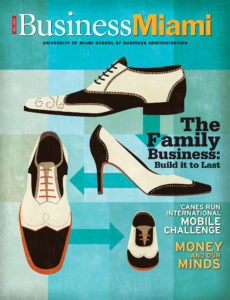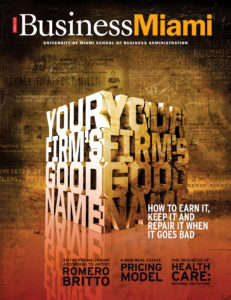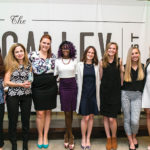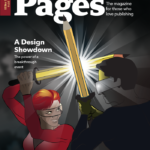
Out of the Crowd
BusinessMiami ditched executives on its cover. Provocative illustrations are in their place. And the risk is paying off.
By Rochelle Broder-Singer
Good— really good — covers get people to open magazines.
And the challenge of creating really good covers is difficult when you are the alumni magazine of a business school. Let me put it this way: How many different ways can you pose people in business suits on the cover and hope it’s interesting?
Until seven years ago, the cover of BusinessMiami, the alumni magazine of the University of Miami School of Business Administration, most often bore a photograph of one or more of the alumni or faculty members featured in that given issue. Sure, we tried to keep it intriguing, posing the individual in a context associated with his or her specialty — say a search and rescue worker in uniform with her canine partners, or health care MBA students and alumni in their lab coats. But too often we had to work with business people in business attire in business settings. Yawn.
In taking this fresh approach, we hoped that BusinessMiami would come to look and read more like a business magazine than a traditional university publication.
As much as our readers may love their alma mater, a photograph of an executive they don’t know or don’t recognize won’t compel them to open to page one.
What does get the attention of business school graduates? Juicy, complex business ideas – that’s what. As we prepared for a magazine redesign, we asked ourselves: How can we effectively represent business ideas on our cover?
EARLY BREADCRUMBS
When I joined the School of Business in 2009, one of my first assignments was to give BusinessMiami a full content and graphic redesign.
As with any redesign worth its weight, we started by collecting input from our readers and stakeholders. The school’s executive director of communications and I poured over a reader survey we had done using the famed CASE survey tool; we conducted interviews with constituents inside and outside of the school; and we researched current trends in university and consumer publications – from Harvard Business Review, Colombia Business School’s Hermes, and Boston University’s Bostonia to Inc., Fast Company, and Fortune. Our research, and in particular our survey results, revealed the No. 1 thing people want to read about in our magazine: current, relevant business ideas.
This was eye-opening for us. We had been giving our readers stories about our successful alumni, our smart students, and our top-tier faculty research. We were talking about us, and with the focus on the person over the topic.
What if we flipped this on its head? What if we enlisted our faculty and alumni to write about the timely business trends and issues about which they are experts, inviting them to share their knowledge and insights? The business topics, rather than the individuals, would move front and center. Instead of writing about alumnus Jose Acosta, president for Latin American operations and public affairs at UPS, we could share his insights on how a multinational company can navigate local markets.
In taking this fresh approach, we hoped that BusinessMiami would come to look and read more like a business magazine than a traditional university publication. Our goal was — and is — to be insightful, to initiate discussion, and to contain need-to-know business information.
This objective is perfectly in line with the magazine’s two-pronged mission: To engage with alumni, students, parents, donors, and faculty; and to brand the school as a leading institution to the business community, recruiters, potential students and their parents, and current and potential donors.
In the scope of our redesign, we identified that the cover could be a clarion call for each issue. It could best broadcast the message, “Hey, we’re tackling this important, relevant topic here!” But, it would have to focus on the central concept and tease it in a smart and compelling way. We decided that, in our case, photos rarely fit this bill. What can stand up to this challenge? Illustrations. A cunning artist can capture the essence of an idea brilliantly — and business concepts provide a rich set of ideas and metaphors for such an artist to play with.
We committed to producing illustrated covers in 2009, and we haven’t looked back.
Over these seven years, we have executed 12 covers in this vein, 10 using illustration and two using a type-only approach. If I may be so bold to say, each one is like a work of art. They are striking and smart, and they garner attention. We have received more reader comments about our covers than anything else in the magazine. Readers notice.
A LITTLE COURAGE
We’ve committed to this approach. But, it’s not always an easy path.
When you assign a photo shoot, you have a high degree of control. You can spell out where the photo will be taken, who will be in it, the background or backdrop, dress code, lighting. If you’re actually at the shoot, you have a good idea of the final product taking shape and can provide on-the-fly direction. During a two-hourlong photo shoot, the photographer can produce a half-dozen cover options for you to mull over.
An illustrated cover, on the other hand, is a delicate dance between editor, designer, and illustrator. Actually, it’s more like a trust fall. We have to deeply trust the illustrator to know our audience and the style of our magazine; to understand what makes a great cover; and most importantly, to get the cover story concept we’re after. There are simply fewer opportunities in this longer artistic process for us to weigh in as the concept takes shape. While we do have a process that helps ensure we’re all on the same page (see Our Process, below), the fact is this: When the artist delivers the final product, weeks after the initial assignment and very close to our closing deadlines, we have our fingers and toes crossed that the piece of art effectively conveys the concept — that it works.

Fall 2015. Sometimes a simple thing can trigger an idea for a cover concept. In this case, a single shoe in illustrator Traci Daberko’s portfolio got me thinking about using shoes as a metaphor for multi-generational family businesses, the topic of our story.


Spring 2014. In looking for just-the-right concept to convey the idea of growing a mid-size company, illustrator Traci Daberko tried a few very different approaches. Once we settled on the building expansion idea, we used her other sketches, like this one, as illustrations within the story.
Illustration can also be comparatively expensive. Our commissioned cover illustration usually costs more than a commissioned cover photo. Fortunately, the total cost is still less than 5 percent of our total magazine budget, which itself is only a small part of the school’s overall communications budget. And, our administration considers the magazine to be an important communication and brand-building vehicle. Given the importance of the cover to the magazine — and the fact that the investment in the rest of the book is worth nothing if nobody opens it — getting budget buy-in for illustrated covers was an easy process for us.
MANAGE the Risk
While there is inherent risk in the illustrated cover approach, we have found some ways to reduce our exposure while maximizing the benefits.
First and foremost, we try to get the total possible value from our investment. For example, we look for opportunities to commission an artist to illustrate both the cover and the corresponding inside story. Most artists will negotiate a package deal that reduces the per-illustration cost, sometimes significantly.
If the illustrator’s fees don’t allow for this, we’ll negotiate a compromise to reduce the amount of work required for the inside illustrations in exchange for reducing the total fee. For example, the artist can reuse elements of the cover image on the inside. When it makes sense, it’s an approach I’m fond of because I find that readers appreciate when the images in the story echo the cover image.
We also use our cover illustration to anchor the magazine website for that issue and for some of our content promotion on social media.
The process can certainly be less-than-smooth. We once had to pay for an illustration we didn’t use, while we instead punted to a type cover. On another occasion, we delayed magazine printing to complete necessary revisions on a piece. In one spectacular scramble, we changed our cover story at the last minute and, with no time to commission art, turned one of the story’s images into a photo illustration for the cover.
Even with the occasional hiccups, is it worth it to take the leap and make a practice of illustrated covers? We say, resoundingly, YES!
The effort is worth it because we know that to thrive as a publication, we need to give our readers what they want: interesting stories about current and relevant business topics. And then we need to draw them into those stories with a compelling teaser that does justice to the content. We find that creative, attractive, interesting illustrations go a long way toward helping us achieve this goal.
Rochelle Broder-Singer has been publications consultant and editorial director of BusinessMiami magazine, the alumni magazine of the University of Miami School of Business Administration, since 2009. Her more than 20 years of editorial and communications work includes nearly a decade in various editorial roles at regional business magazines. Connect at tinyurl.com/linkedin-singer.
OUR PROCESS
As with any creative process, things never happen the same way twice (and isn’t that part of the fun in what we do?). That said, this is the process we have found to be effective when commissioning an illustrated cover.
Our team:
Rochelle Broder-Singer: editorial director
Jeff Heebner: executive director of communications
Paul DiMattia: freelance design director
STEP 1: CHOOSE COVER STORY
Jeff Heebner and I look for a topic in our issue’s schedule that is relevant to our readers’ business lives or to personal investing; that is timely but not so timely that it won’t be valuable six months from now; and that can showcase the expertise of our faculty or alumni. We run this cover story by the dean and the executive director of alumni relations and development.
STEP 2: BRAINSTORM CONCEPTS & STYLE
Once we’ve received buy-in on the topic, Paul DiMattia and I brainstorm several illustration concepts and discuss artistic styles that might work with the topic. I highlight any political issues, internal sensitivities, or other potential pitfalls we may encounter.
STEP 3: SELECT ILLUSTRATOR
DiMattia sends the team portfolio links for a few potential illustrators, based on their styles and whether they’ve created illustrations on similar topics. When we first began commissioning cover illustrations, every illustrator we worked with was new. Now, we have experience with several excellent artists, so at least one is someone we’ve worked with before. DiMattia usually makes a recommendation at this stage. Heebner and I review the illustrators’ work and choose one – often the same one DiMattia suggested.
STEP 4: MIND-MELD WITH ILLUSTRATOR
The illustrator joins our team in a conference call designed to be our central brainstorming session. The story isn’t written at this point; interviewing may just be getting started. What we have to work with is the one-paragraph pitch I made to the dean; the assignment I’ve given the writer, often with bullet points I hope the writer will cover; and any pertinent faculty research that’s been done on the topic. If we have any headline ideas, we also share these because they can inspire the cover illustrations, even if the headline itself is ultimately discarded. The best illustrators ask a lot of questions.
STEP 5: REVIEW INITIAL SKETCHES
Several weeks later, the illustrator gives DiMattia rough concept sketches. They may go back and forth a few times until DiMattia feels he has two to three sketches to share with our team. If we like the options, Heebner and I choose our favorite; show it to the dean for approval; and provide written feedback to DiMattia and the illustrator. If none of the sketches work, we go back to the illustrator for a restart.
STEP 6: RUN WITH A CONCEPT
The illustrator takes the concept sketch to the next level, creating a potential cover illustration but not yet applying any final touches. Sometimes, the illustrator creates several options for this round as well (depending on how much his/her process allows). Once DiMattia is satisfied, he’ll put the illustration into a template that includes our masthead, school name, dateline, and coverlines from an old issue.
Heebner and I examine the potential cover(s). If we like what we see, we’ll share the illustration with others in alumni relations and development, as well as other members of the school’s communications team. I also may post the illustration (no cover lines) on the front wall of my workspace so I can look at it for a while and get comments from others passing by. This is a great opportunity to find out if people get the concept. Finally, we remove the coverlines and send the cover to the dean for a final “thumbs-up, thumbs-down.”
STEP 7: FINALIZE ILLUSTRATION
Once we have chosen the final illustration, the illustrator fully develops and completes it. With some artists, this can lead to a final image that is far evolved from the original – for example, from a black pencil sketch to a fully detailed colored painting, drawing, or digital image. For others, this stage may simply mean adding backgrounds, texture, and final details.

Spring 2010. We gave illustrator Dung Joang a headline and deck to work with. He brought the concept to life with this creative word/art play and social media-inspired background.



